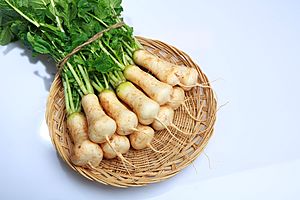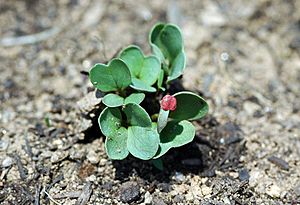Chonggak radish facts for kids
Quick facts for kids ChonggakmuChonggak radish |
|
|---|---|
 |
|
| Species | Raphanus raphanistrum |
| Subspecies | R. raphanistrum subsp. sativus |
| Cultivar group | White radish group |
| Origin | Korea |
| Korean name | |
| Hangul |
총각무
|
|---|---|
| Hanja |
總角-
|
| Revised Romanization | chonggangmu |
| McCune–Reischauer | ch'onggangmu |
| IPA | [tɕʰoŋ.ɡaŋ.mu] |
Chonggakmu or Chonggak radish, also called ponytail radish, is a special kind of white radish. It's smaller than regular radishes and has lots of thin roots. The cool thing is, the whole plant, including its leaves and stems, is used in Korean cuisine to make yummy dishes!
What's in a Name?
The name chonggakmu comes from two Korean words: chonggak and mu.
- Mu (무) simply means "radish."
- Chonggak (총각) means "bachelor" or an unmarried young man.
Long ago in Korea, young men and boys who weren't married would wear their hair in a long braid. When they had a special coming of age ceremony, their braid was styled into two horn-like topknots called chonggak. Later, when they got married, their hair was tied into a single topknot called sangtu.
Because the shape of these radishes looks a bit like the chonggak hairstyle, people started calling them chonggak radishes!
What Does It Look Like?

The main roots of the chonggak radish are called taproots. They usually weigh about 60 to 80 grams. This makes them about ten to thirteen times smaller than a regular Korean radish.
The roots are typically 8 to 9 centimeters long. The part of the plant that grows just above the root, but still underground, is called a rhizome. These are about 2 to 3 centimeters long. From these underground stems, long, oval-shaped leaves grow upwards.
How Is It Used in Cooking?
Chonggak radishes are very popular in Korean cooking.
- The green leaves of the radish are called mucheong. These greens can be dried to make siraegi, which is used in soups and stews. They can also be used fresh in many dishes.
- One of the most common ways to use chonggak radishes is to make a type of kimchi called chonggak-kimchi. For this, the whole radishes, along with their leaves and stems, are used. They can be kept whole, cut in half, or quartered. The seasonings are similar to those used for kkakdugi, which is another type of radish kimchi.
- Chonggak radishes can also be used to make dongchimi. This is a special kind of soupy kimchi that's often enjoyed in the winter. It's refreshing and a bit tangy.
-
Dongchimi (radish water kimchi) made with chonggak radishes



